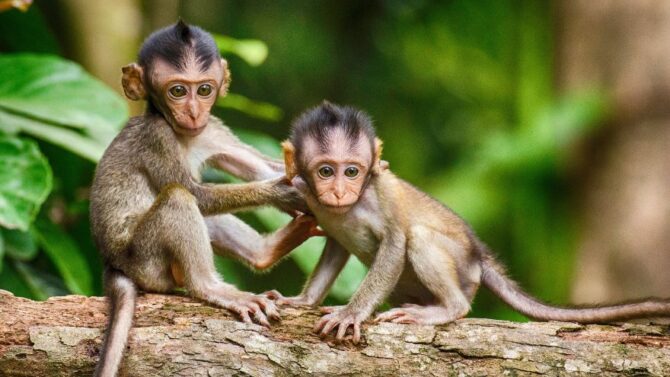Hawaii is a state in Western United States popular for its beautiful beaches, lush rainforests, and diverse wildlife.
However, did you know that despite its wide variety of indigenous wildlife, you can’t find any monkeys in Hawaii?
Unfortunately, the popular claim that Hawaii is home to wild monkeys is only a misconception. However, there are various other interesting endemic animal species to explore in Hawaii.
In this article, we’ll explore the reasons behind the absence of these primates on the islands and some other amazing wildlife that inhabit the state.
Why Are There No Wild Monkeys in Hawaii?
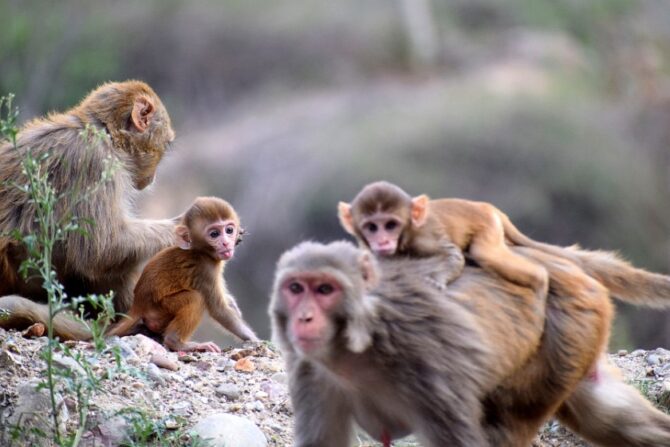
Hawaii is home to a diverse range of plants and animals, including many species found nowhere else in the world.
However, wild monkeys are not native to Hawaii.
They were never part of the island’s ecosystem and have not been introduced by humans in the past, unlike other tropical destinations like Costa Rica and Thailand, which have wild monkey populations due to human introduction.
Hawaii’s isolation as an archipelago in the Pacific Ocean, formed through volcanic eruptions, largely contributes to its unique and diverse ecosystem.
The island is home to two native mammal species, the hoary bat and monk seal, and about five species of indigenous reptiles and amphibians.
Wildlife Species You Might Encounter in Hawaii
Hawaii may lack wild monkeys, but its land and waters are home to a wide variety of unique and magnificent animals.
Below are just some of the wildlife species you may encounter in Hawaii:
Hawaiian Hoary Bat (Endemic Species)
Scientific Name: Lasiurus cinereus semotus

The Hawaiian hoary bat is a subspecies of the hoary bat that is indigenous to the Hawaiian Islands.
It can be found on Kauai, Oahu, and Maui and is the only native land mammal in Hawaii.
The Hawaiian hoary bat is so named for its fur’s hoary color (gray or white) and is an insectivorous species, feeding on various insects such as moths, beetles, and mosquitoes.
It is also an important predator in the Hawaiian ecosystem, helping to control the populations of these insects.
The hoary bat is a nocturnal hunter that’s unfortunately listed as a species of concern by the U.S. Fish and Wildlife Service1 due to its limited range and the potential for habitat loss and degradation.
Fortunately, conservation efforts are being implemented to protect the bat and its habitat, including developing conservation plans and establishing protected areas.
Hawaiian Monk Seal (Endemic Species)
Scientific Name: Neomonachus schauinslandi

Native to the Hawaiian Islands, the Hawaiian monk seal is an earless seal that is in danger of extinction.
It has a population of almost 1,600 individuals, with nearly 1,200 seals in the Northwestern Hawaiian Islands and 400 seals in the main Hawaiian Islands.2
The Hawaiian monk seal has a sleek, medium-sized body with a narrow snout and large front flippers.
Its fur is typically light to dark gray and lighter on its underside.
The Hawaiian monk seal is the official mammal of Hawaii, and its native name is “Ilio-holo-i-ka-uaua,” which means “the dog that runs in rough water.”
Due to its dwindling population, this creature is protected by the Endangered Species Act and the Marine Mammal Protection Act.
Conservation efforts for the species are also underway, including habitat protection, removal of marine debris, and population research and monitoring.
Threats to the Hawaiian monk seal include habitat loss and degradation, marine debris entanglement, and invasive species predation.
Nene Goose (Endemic species)
Scientific Name: Branta sandvicensis

The nene, also known as the Hawaiian goose, is Hawaii’s official state bird and the only goose native to the United States.
It has a distinctive appearance: a black head and neck, brown back and wings, and a white underbelly.
It also has long, thin legs and a small bill and feeds on grasses, seeds, and insects.
The Hawaiian goose is believed to have evolved from the Canadian goose and is now found mostly on Hawaii, Maui, and Kauai islands.
In the past, the nene was heavily hunted, and its population declined to 30 individuals in the 1950s.3
However, conservation efforts have helped increase its population, and the nene is now considered a threatened species, with only over 2,000 individuals in the wild.
Fortunately, conservation efforts are ongoing to protect and restore the species.
Hawaiian Spinner Dolphin (Endemic species)
Scientific Name: Stenella longirostris
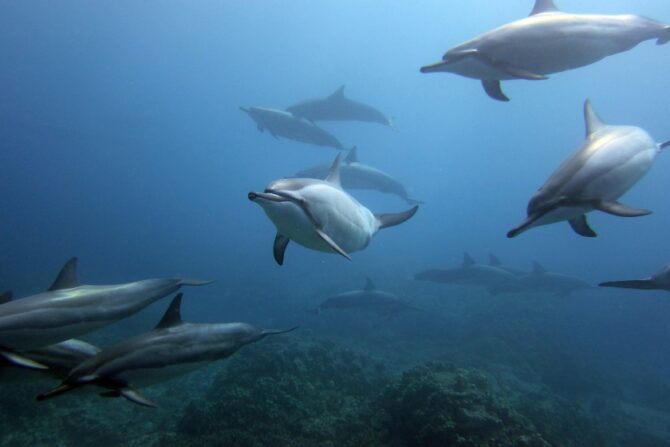
The Hawaiian spinner dolphin is a small dolphin known for its social behavior and acrobatic spinning movements.
It is found in the waters around Hawaii and is one of three subspecies of spinner dolphins.
These dolphins are often found in large groups called pods and have complex social relationships within these groups.
They are also endangered and are protected under the Endangered Species Act due to threats such as habitat loss, pollution, and entanglement in fishing gear.
Thankfully, conservation efforts are being implemented to help protect and restore their populations.
Oahu is a particularly good place to observe these dolphins, especially very early in the morning.
Hawaiian Green Sea Turtles (Endemic species)
Scientific Name: Chelonia mydas
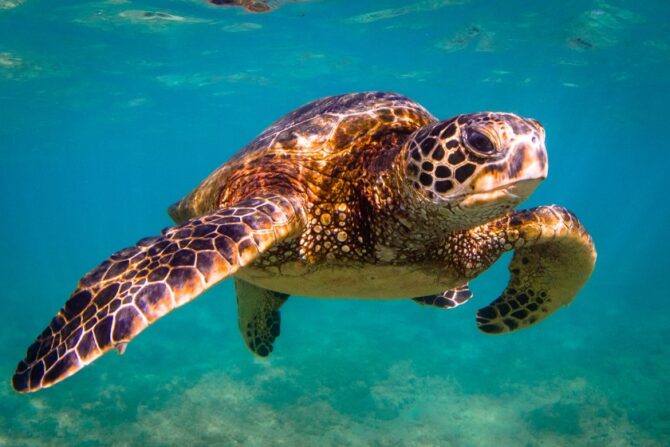
The Hawaiian green sea turtle, also known as the honu, is a subspecies of green sea turtle native to the Hawaiian Islands.
These turtles are known for their dark green or black carapace and pale yellow or white plastron.
They can be found in shallow coastal waters of the Hawaiian Islands, where they feed on seaweed, algae, and other marine plants.
Hawaiian green sea turtles migrate between their feeding and breeding grounds.
They are culturally and ecologically important in Hawaii and are protected as a threatened species due to habitat loss, hunting, and other human activities.
However, conservation efforts are underway to protect their habitat and educate the public about their ecological significance.
Humpback Whale
Scientific Name: Megaptera novaeangliae
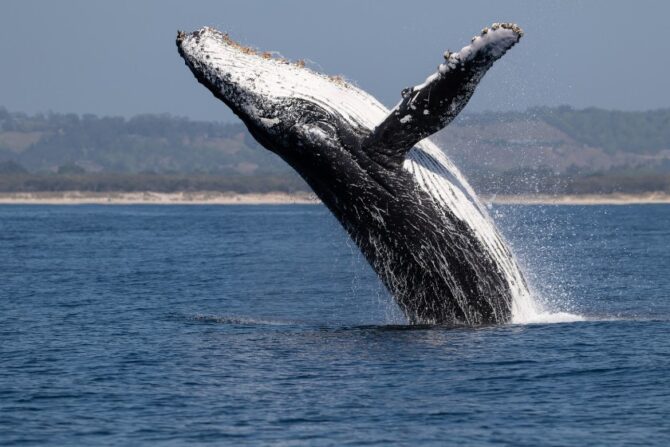
Humpback whales are frequently seen in Hawaii during the winter months of November to May.
These whales migrate to Hawaii’s warm waters to mate and give birth after feeding in the colder waters of Alaska.
Humpback whales hold significant cultural value for the indigenous Hawaiian people and are the state’s official aquatic mammal and overall state animal.
These whales are known for their acrobatic displays, such as breaching and tail slapping, as well as their vocalizations, which can be heard for miles underwater.
Humpback whales are often found in pods and can be observed on whale-watching tours in Hawaii, particularly along the coast of Maui.
As humpback whales are protected under the Endangered Species Act and the Marine Mammal Protection Act, it is important to respect their space and not disturb them while they are on their breeding grounds.
Hawaiian Reef Triggerfish
Scientific Name: Rhinecanthus rectangulus

The Hawaiian reef triggerfish, also known as the humuhumunukunukuapua’a, is a fish found in the tropical waters of the central and western Pacific oceans.
It is well-known for its distinctive appearance and behavior and is popular among marine aquarists.
The triggerfish gets its name from the three spines on its back that it can raise to defend itself against predators.
These fish are known to be aggressive and often bite swimmers.
In the wild, the Hawaiian triggerfish can be found in coral reefs, lagoons, and tide pools, where they feed on small fish, crustaceans, and other invertebrates.
Caring for them in an aquarium can be challenging due to their territorial behavior and large size.
They require a large tank with plenty of hiding places and should not be kept with smaller or more delicate fish.
It is equally important to provide them with a varied diet and monitor their behavior to ensure they do not harm other fish in the tank.
Are There Dangerous Animals in Hawaii?
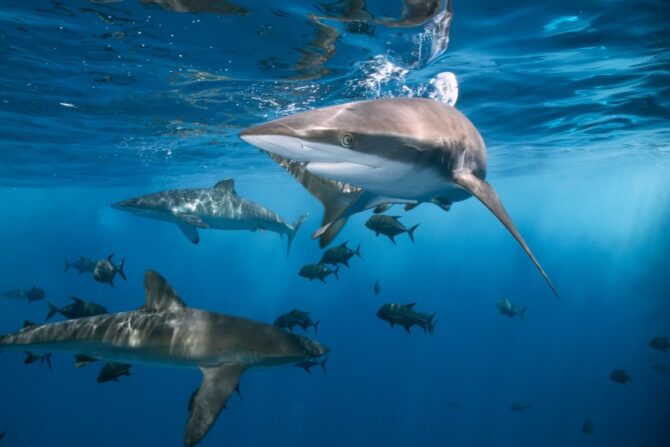
Hawaii is a safe place to visit, as it is isolated in the middle of the Pacific Ocean and does not have many dangerous animals.
However, some sea animals, such as sea snakes and sharks, can be dangerous to humans.
While shark attacks are rare, the cases that occur can be fatal.
Another animal to look out for in Hawaii is the Conus snail, which has a toxin that can be deadly to humans.
Some insects can sting or bite humans, such as centipedes and mosquitoes.
In addition, caution should be exercised around sea urchins and coral, as they can cause injury if someone steps on them or comes into contact with them in the water.
However, while there are some potential dangers in Hawaii, the risk of being harmed by wildlife is low.
Frequently Asked Questions
How Many Monkeys Are in Hawaii?
There are no wild monkeys in Hawaii.
The Hawaii islands are far from any other land masses, so few land animals are native to the area.
However, you can visit the Honolulu Zoo to see some monkeys.
Are There Gorillas in Hawaii?
Gorillas are present in Hawaii, but their population is strictly controlled due to their status as endangered/threatened species and restricted animals.
Are There Mountain Lions in Hawaii?
Mountain lions, also known as cougars or pumas, are not found in Hawaii, as they are not native to the islands.
They are native to the Americas and are found in many parts of the United States.
It’s worth noting that Hawaii has no native species of large carnivorous mammals because its unique ecosystem developed in isolation.
Are There Wolves in Hawaii?
Hawaii is an island chain located in the Pacific Ocean and does not have wolves native to the Northern Hemisphere.
Instead, it has a unique ecosystem with unique plants and animals, including the
Hawaiian hoary bat and the endangered Hawaiian monk seal.
Are There Coyotes in Hawaii?
There are no coyotes in Hawaii.
Coyotes are not native to the Hawaiian Islands and are not found among the wildlife species that can be encountered in the tropical environment.
Are There Squirrels in Hawaii?
Hawaii has no squirrels because the islands are isolated in the Pacific Ocean and have a unique ecosystem.
However, the islands are inhabited by mongooses, which can be found near bushes and in the mountains.
Although they may seem cute and furry, mongooses are considered invasive because they eat birds and their eggs, which can harm the island’s bird population.
Mongooses were originally introduced to control the rat population but have now become a problem themselves.
Are There Bears in Hawaii?
There are no bears in the wild in Hawaii.
You would have a better chance of seeing a bear at the Honolulu Zoo, where there are two sun bears.
These bears can often be found sunbathing and climbing trees in their enclosure at the zoo.
Conclusion
Is it possible to find monkeys in Hawaii?
The answer is no because Hawaii does not have any native monkey populations.
Although the island’s lush vegetation and forests may seem like a suitable habitat for monkeys, the primates are not native to the island.
If you want to observe monkeys in the wild, many other locations worldwide are home to these intelligent and social animals. Some of the best places to see monkeys include zoos, national parks, and reserves in Costa Rica, India, Uganda, Pennsylvania, and Cincinnati.
References & Notes
- Hawaiian Hoary Bat (Lasiurus cinereus semotus). U.S. Fish & Wildlife Service
- Hawaiian Monk Seal. NOAA Fisheries
- Nene. Britannica
